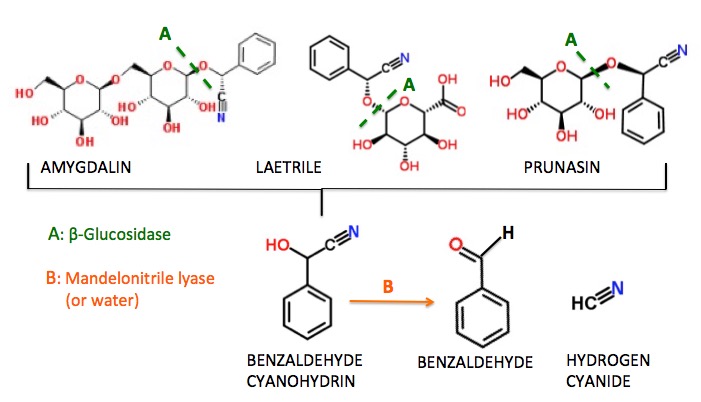There can be no better example of the damage done by quackery masked as "alternative medicine" than the tragic case of Chad Green. In 1977, at age two, Green was diagnosed acute lymphocytic leukemia (ALL). At that time the cure rate for childhood ALL with chemotherapy was about 50%. Now it is about 90%. Chad Green died in 1979, a victim of uninformed parents and quacks that exploited them.
For the full story, which is heart-wrenching, I cannot recommend highly enough the first chapter of Dr. Paul Offit's book, "Do You Believe in Magic? The Sense and Nonsense of Alternative Medicine." Offit takes on quackery of all forms in a way that will leave readers shaking their heads in disbelief. The laetrile chapter is particularly poignant.
KILLING A KID WITH QUACKERY
In short, Green, who was initially given standard chemotherapy for his leukemia, and was responding well when his parents decided that a "natural" cure for cancer called laetrile was a better choice. The fact that the "drug" was not (and will never be) approved in the US, but was available at clinics in Mexico should have raised a red flag, but the Greens and their son were victims of horrific misinformation, which astoundingly, continues today. More on that later. First a look at the chemistry, which should explain why laetrile is not a useful drug, merely a useful poison.
LAETRILE AND AMYGDALIN ARE NOTHING MORE THAN MASKED CYANIDE
Contrary to popular belief, laetrile and amygdalin, a related chemical from apricot seeds are not the same substance. But for practical purposes, it doesn't matter because they both break down to give the "active agent" - hydrogen cyanide, a killer. All it takes is a couple of enzymes and maybe a molecule of water (Figure 1).
Figure 1. The conversion of three related cyanoglycosides from apricot pits to hydrogen cyanide. Step A: ß-Glucosidase, an enzyme that removes glucose molecules from whatever they are attached to, breaks the carbon-oxygen bond (green hatched line) that attaches glucose to benzaldehyde cyanohydrin. Step B: Benzaldehyde cyanohydrin is further broken down by either by water or by the enzyme mandelonitrile (1) lyase to form benzaldehyde and hydrogen cyanide aka prussic acid (2). Chemical structures courtesy of Chem Spider.
LITERATURE EVIDENCE - IS THERE ANYTHING HERE?
When looking for high-quality review articles about whether a drug or treatment is good, bad, or otherwise, Cochrane Reviews are about as good as it gets. This is because the quality of the evidence of each individual study is evaluated to determine whether it meets the standards for inclusion in the review. A 2011 Cochrane Review entitled "Laetrile treatment for cancer" does not mince words (emphasis mine):
"The claims that laetrile or amygdalin have beneficial effects for cancer patients are not currently supported by sound clinical data. There is a considerable risk of serious adverse effects from cyanide poisoning after laetrile or amygdalin, especially after oral ingestion. The risk-benefit balance of laetrile or amygdalin as a treatment for cancer is therefore unambiguously negative."
S. Milazzo, et. al, Cochrane Database Syst Rev. 2011 Nov 9;(11):CD00547
Irving J. Lerner, an Associate Professor of Medicine in the Department of Medicine at the University of Minnesota Medical School displays considerable less subtlety in his 1981 article in Cancer Journal for Clinicians entitled "Laetrile: A Lesson in Cancer Quackery."
“[T]he slickest, most sophisticated, and certainly the most remunerative cancer quack promotion in medical history.”
I. J. Lerner, M.D., April, 1981
WHAT DO THE CRACKPOTS HAVE TO SAY?

Image: Beer Street Journal
When looking for crackpot theories, one simply cannot go wrong starting with "Crazy Joe" Mercola. As usual, Mercola does not disappoint (emphasis mine):
In the early 1970s, America’s war on cancer was in full force, and Sloan Kettering was regarded as one of the world’s leading cancer research centers. But Sloan Kettering’s Board of Directors swept positive findings about Laetrile under the rug when it became unprofitable and publicly unpopular for them to support it.
"Crazy Joe" Mercola. 'New Film “Second Opinion” Exposes the Truth About a 40-Year Long Cover-Up of Laetrile Cancer Treatment.' October 2014. Just another day in Mercolaville.
It gets worse, and if you're thinking that this is impossible it's because you haven't subjected yourself to the Natural News website of Mike "The Health Stranger" Adams, who makes Mercola sound like a Nobel Prize winner. A 2009 article about laetrile written by Paul Fassa on the Natural News site should provide ample evidence that things can always be worse. Like the title:
"Apricot Seeds Kill Cancer Cells without Side Effects"
Paul Fassa, Natural News, September 2009
If you're done spitting up, let's take a look at some of Fassa's claims.
"Since laetrile is derived directly from a food substance in nature and not chemically developed in a laboratory, it is impossible to patent."
Wrong. Try reading about "use patents." Natural products are routinely patented and many have become drugs. Patents for useless and poisonous natural products, not so often.
"And of course, it's not toxic"
This may be the six dumbest consecutive words in the history of the English language.
"In other words, just as with all natural healing substances, Big Pharma and the AMA can't make a fortune from the substance and from the remedies for the long term [sic] side effects."
Perhaps the only correct sentence on the page. No - neither big pharma nor the AMA (????) can make a fortune selling cyanide. Rather small market.
"There have been several testimonies from cancer victims who cured themselves by chewing large quantities of the apricot seeds alone."
There have also been several testimonies from people who claim that Elmer Fudd was seen flying one of the chemtrails planes dropping poisonous chemicals on the entire surface area of the US, presumably to take control of the minds of those few who managed to escape fluoride thought control.
OK, enough of this. If you want to take laetrile for your cancer, knock yourself out (although that won't really be necessary; the laetrile will do this job quite nicely). But understand that you will be following the advice of people who probably didn't have time for a chemistry course. Or failed it if they did.
This is quackery at its worst. Disgusting.
NOTES:
1. The name Laetrile was derived from L-mandelonitrile, another name for benzaldehyde cyanohydrin. This makes matters even more confusing because there are at least two different chemical structures of the chemical called laetrile, and neither is L-mandelonitrile. L-mandelonitrile is not laetrile it will poison you just as easily. Maybe even easier.
2. Let the quacks scream their quacky heads off. There is no such thing as Vitamin B17. And the breakdown product of laetrile or amygdalin is HYDROGEN CYANIDE. Hydrogen cyanide, which was used in the gas chamber in Nazi concentration camps, is also called prussic acid. They are one and the same.




